Pulled from my website here:
https://www.erinsaudiocorner.com/loudspeakers/dutch_dutch_8c/
Note: The YouTube review isn't up yet. Hopefully will be this weekend. Didn't want to put off the release of the data any further.
Dutch & Dutch 8c Speaker Review

Foreword / YouTube Video Review
The review on this website is a brief overview and summary of the objective performance of this speaker. It is not intended to be a deep dive. Moreso, this is information for those who prefer “just the facts” and prefer to have the data without the filler.
However, for those who want more - a detailed explanation of the objective performance, and my subjective evaluation (what I heard, what I liked, etc) - please watch the below video where I go more in-depth.
(Coming Soon)
Information and Photos
I have provided a introduction to this speaker on my YouTube channel and provided below.
The Dutch & Dutch 8c is a powered bookshelf speaker that is quite the departure from the typical bookshelf speaker. Its cardioid design means it is practically all forward-firing above approximately 100Hz. This enables the listener to place the speakers very close to a rear wall and get the benefit of boundary reinforcement without the negative characteristic of rear-wall reflections. It’s quite a neat theory that also has remarkable sonic achievements in practice.
The front of the speaker features a 1-inch dome tweeter and 8-inch midrange. The crossover between these two driver units is 1250Hz. The front baffle is one piece that fits over the drivers, resulting in a very smooth waveguide for the tweeter (notice the lack of screw heads and holes) as well as a smooth lip even on the midrange.
The rear features dual 8-inch subwoofers which play below 100Hz. The rear also contains the I/O ports (AES digital, as well as balanced analog via XLR) and even a pass through for a separate subwoofer.
The Dutch & Dutch 8c is an “all in one” product. It features a built-in amplifier with DSP allowing the user to tailor the speaker to their own tonal desires (bass, mid and treble adjustments). The 8c is also designed to integrate with Room EQ Wizard for room equalization. This feature works very well and is very easy to navigate and implement. The speaker connects to your network via wired ethernet cable. Once connected you can access the speaker’s DSP, volume control, source selection (analog/AES), etc. via your web browser. It is really quite easy and convenient.
I have taken the liberty of providing a screenshot of the technical specs from the manufacturer’s page, provided below:
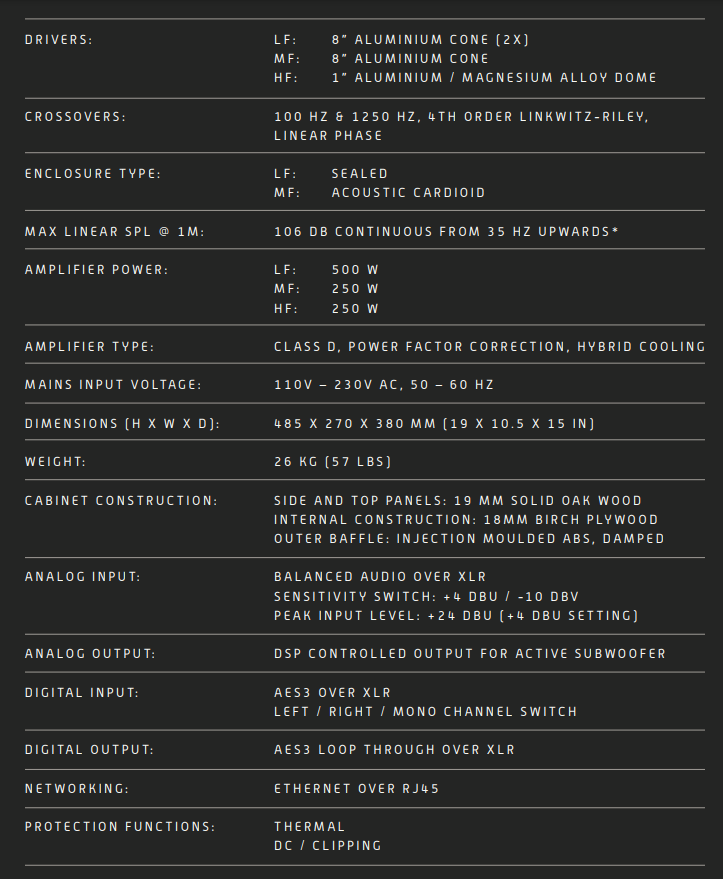



CTA-2034 (SPINORAMA) and Accompanying Data
All data collected using Klippel’s Near-Field Scanner. The Near-Field-Scanner 3D (NFS) offers a fully automated acoustic measurement of direct sound radiated from the source under test. The radiated sound is determined in any desired distance and angle in the 3D space outside the scanning surface. Directivity, sound power, SPL response and many more key figures are obtained for any kind of loudspeaker and audio system in near field applications (e.g. studio monitors, mobile devices) as well as far field applications (e.g. professional audio systems). Utilizing a minimum of measurement points, a comprehensive data set is generated containing the loudspeaker’s high resolution, free field sound radiation in the near and far field. For a detailed explanation of how the NFS works and the science behind it, please watch the below discussion with designer Christian Bellmann:
A picture of the setup in my garage:
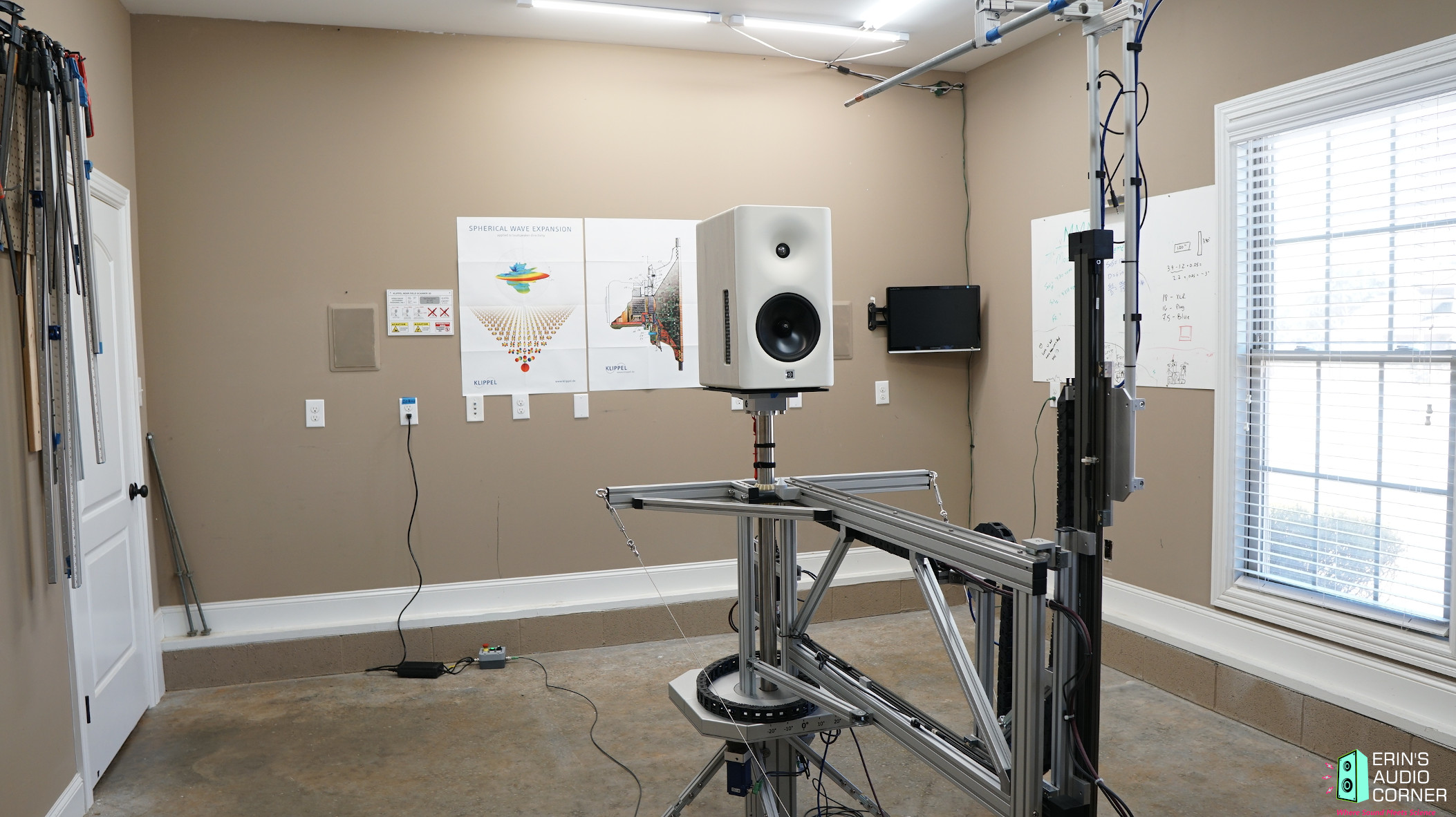
The reference plane in this test is halfway between the tweeter and the midrange, as shown in the image below:

Measurements are provided in a format in accordance with the Standard Method of Measurement for In-Home Loudspeakers (ANSI/CTA-2034-A R-2020). For more information, please see this link.
CTA-2034 / SPINORAMA:
Note: Since this is a powered speaker, the SPL readings in the below graphics was not the SPL tested. Per the CTA-2034 sped, the input voltagge is 2.83v. However, this speaker was tested at a level more in line with approximately 86dB at 1m (0.30vRMS input). The output SPL is scaled based on the 2.83v, though. Therefore, at 2.83v input to this speaker, the output is shown as below.
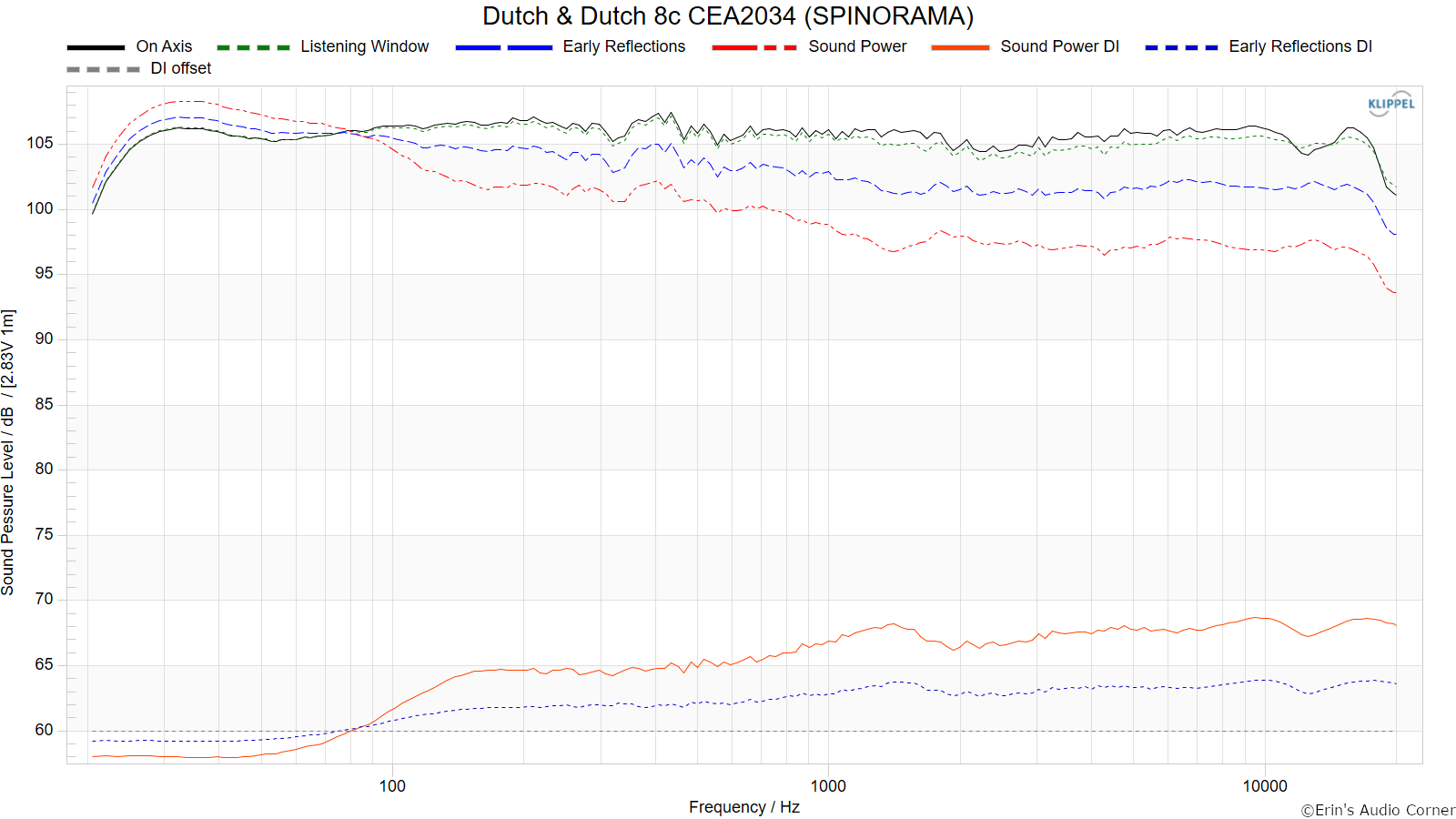
Early Reflections Breakout:
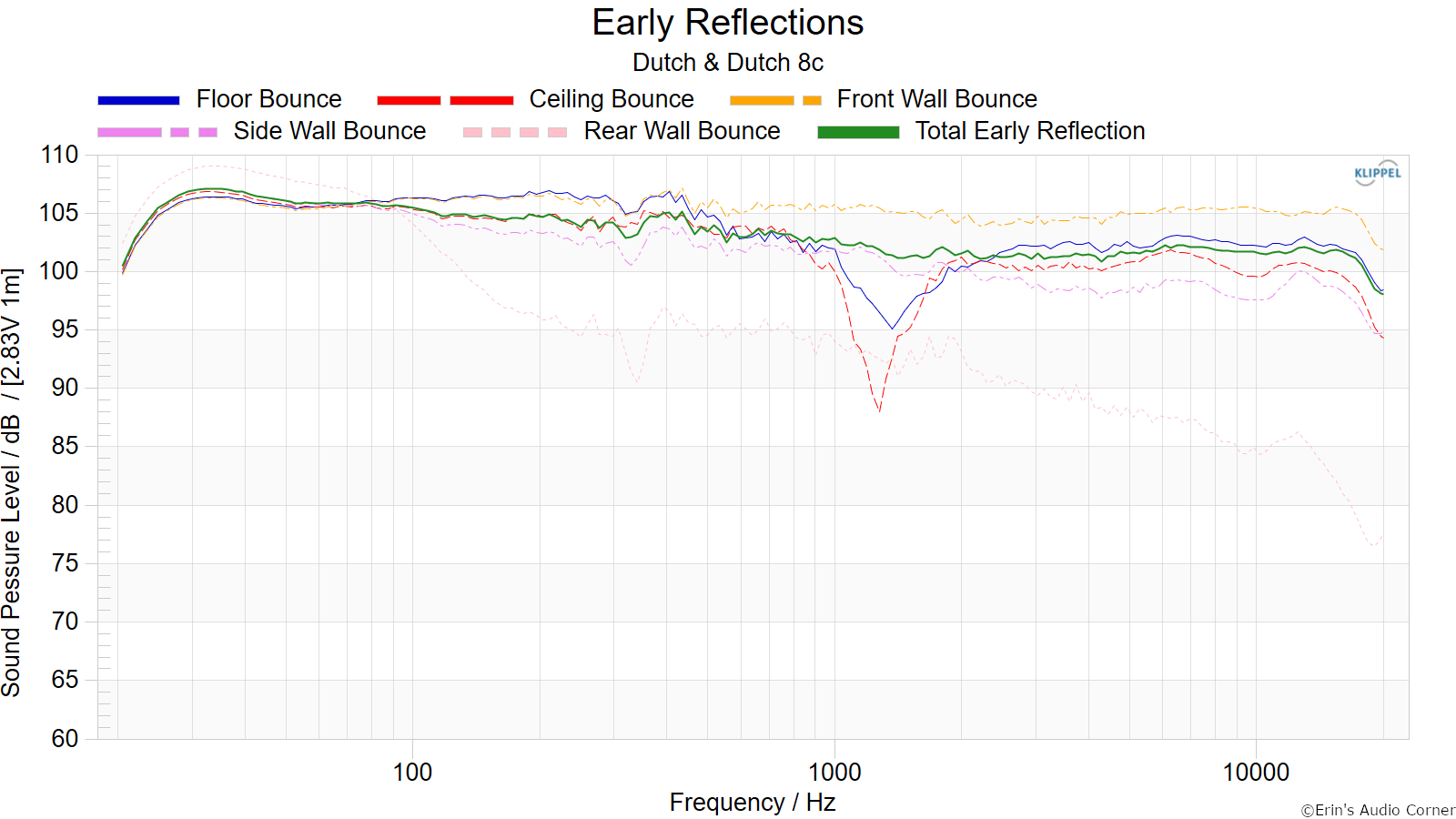
Estimated In-Room Response::

Horizontal Frequency Response (0° to ±90°):

Vertical Frequency Response (0° to ±30°):

Horizontal Contour Plot (not normalized):

Horizontal Contour Plot (normalized):

Vertical Contour Plot (not normalized):

Vertical Contour Plot (normalized):

Additional measurements
Nearfield response of individual drive units with anechoic on-axis response:

Harmonic Distortion at 86dB @ 1m:

Harmonic Distortion at 96dB @ 1m:

Horizontal Polar (Globe) Plot: This represents the sound field at 2 meters - above 200Hz - per the legend in the upper left.
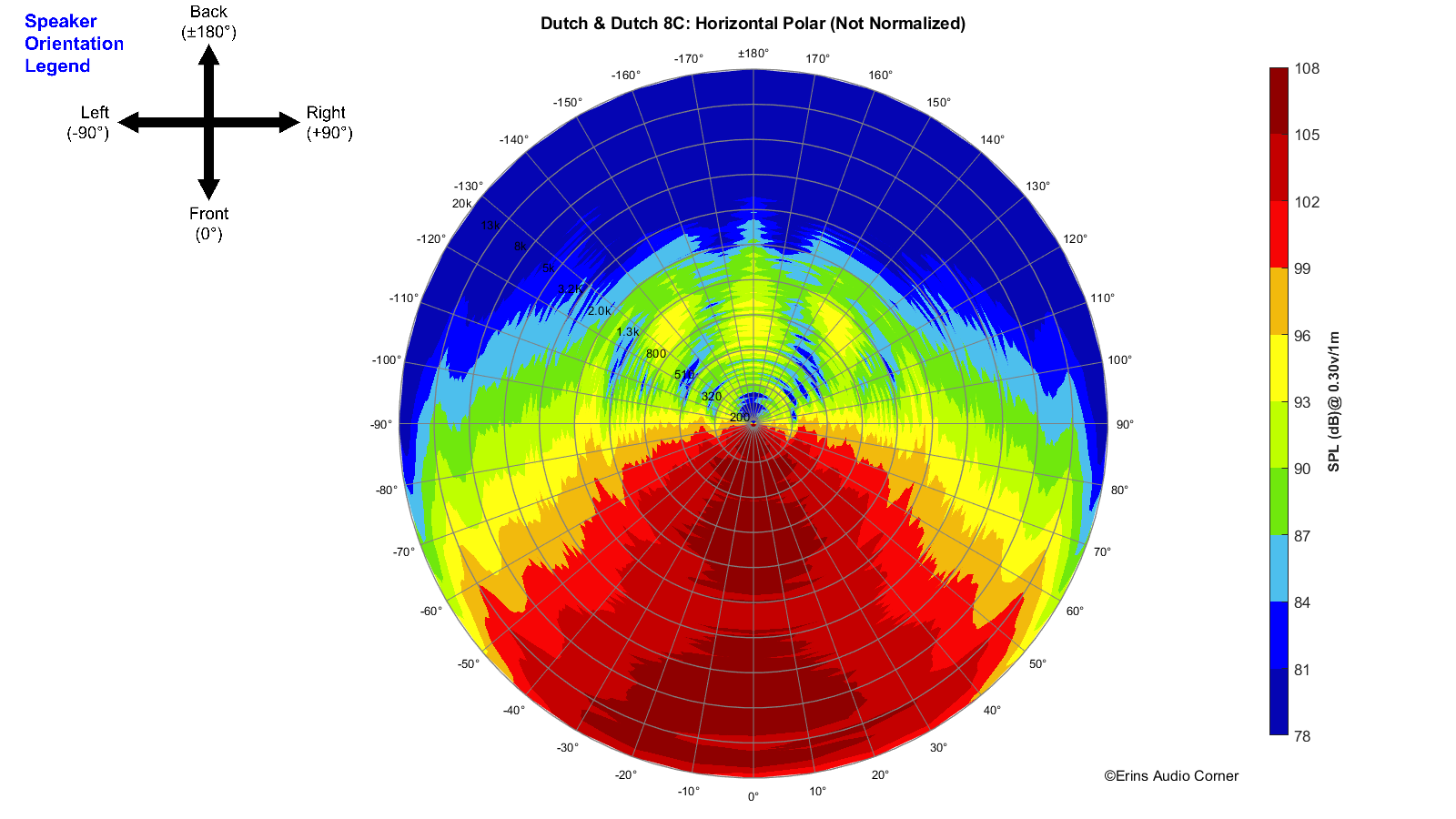
Vertical Polar (Globe) Plot: This represents the sound field at 2 meters - above 200Hz - per the legend in the upper left.

“Above and Beyond” Measurements
Anechoic vs Boundary Loaded
These measurements are outside of my typical measurement set but I feel are necessary to provide additional insight in to the performance of this speaker. Thus, the “above and beyond” tag.
The Dutch & Dutch 8c is a speaker that breaks the norm. It is designed to be placed near a back wall in order to provide boundary gain. In order to achieve boundary gain, however, a typical speaker also loses timbre due to the rear wall reflections. With a cardioid speaker (such as the D&D 8c), the rear wall reflections are effectively “muted” and you are left with a forward-firing only speaker above 100Hz (below which, the subs are omnidirectional but cut off above this frequency sharply).
This presents a bit of a challenge when analyzing performance. Ideally you measure a speaker anechoically to see what happens when the room is not a factor in the performance. So, I did that using Klippel’s NFS which you saw above. This gave us all a baseline understanding of the speaker’s anechoic performance. However, I also needed a way to characterize performance in the situation it is designed for: near a boundary for below approximately 100Hz reinforcement. Therefore, I used high level engineering (see: scrap wood) to build a platform for the speaker so the subwoofers could load off the ground - effectively becoming the “rear wall”, if you will. And then I measured the performance in this manner. Now we have not only a full SPIN set of data for anechoic measurements but we also have a quasi-anechoic measurement via the ground plane method to see how the boundary loading changes performance.
Setup:

The 8c’s DSP settings were tested both “free” and set to “10cm” from the backwall. “Free” is essentially telling the speaker there is no rear wall behind it and there is no shelving of the bass. “10cm” is intended to emulate placement against a backwall in a real room and, when placed near a rear wall, will shelve the bass so the response is more neutral. As you can see in the below graphic, when the speaker is placed near a boundary and set to “free” the SPL increases from 0dB at 200Hz to approximately +6dB below about 80Hz. This gives us an idea of what to expect in a real room (to some degree). Ultimately, the takeaway here is that boundary gain works as expected and if you want a neutral response then the DSP should be set in accordance with the in-room backwall distance from the speaker.

Cardioid Performance
Conventional speakers are omnidirectional at low frequencies and become more directional at higher frequencies. Omnidirectional means that the sound is radiated 360° around the speaker. More directional means that the sound is “focused” more forward than it is behind or to the sides. For most bookshelf and floorstanding speakers, this is true below about 400-500Hz. Sometimes higher; sometimes lower. This is usually dictated by the size of the drive units used in the speaker.
A cardioid speaker - like the Dutch & Dutch 8c is designed to not be omnidirectional above a certain frequency, and in the case of the 8c that frequency is 100Hz. Why would this be useful? Well, remember, the 8c features subwoofers on the rear of the speaker. These subwoofers depend on boundary reinforcement in order for the response to extend as low as possible in frequency. The issue, typically, would be rear-wall reflections. If the 8c speaker had the upper midbass and lower midrange frequencies radiating backwards then there would be a high degree (no pun intended) of sound traveling rearward only to be reflected off the rear wall and back to the front of the speaker causing comb filtering in these lower frequencies. In terms of sound, this can (and typically does) result in marred tonality, impact and imaging of the mid-to-low frequencies at the listening position. The 8c claims to have “constant directivity” above 100Hz; something it does through its cardioid design.
How well does this actually work, though? Well, let’s take a look at the typical response of a generic studio monitor at 200Hz. The below graphic is a plot of the sound field of said speaker at 200Hz. This was generated using Klippel’s Near-Field Scanner and Visualization module. The story here is the sound is a big ball of energy, radiating in all directions. In front (illustrated by the red arrow), backwards, up and down. This energy is all practically the same SPL, too. Nothing new here. Typical of a standard monopole speaker.
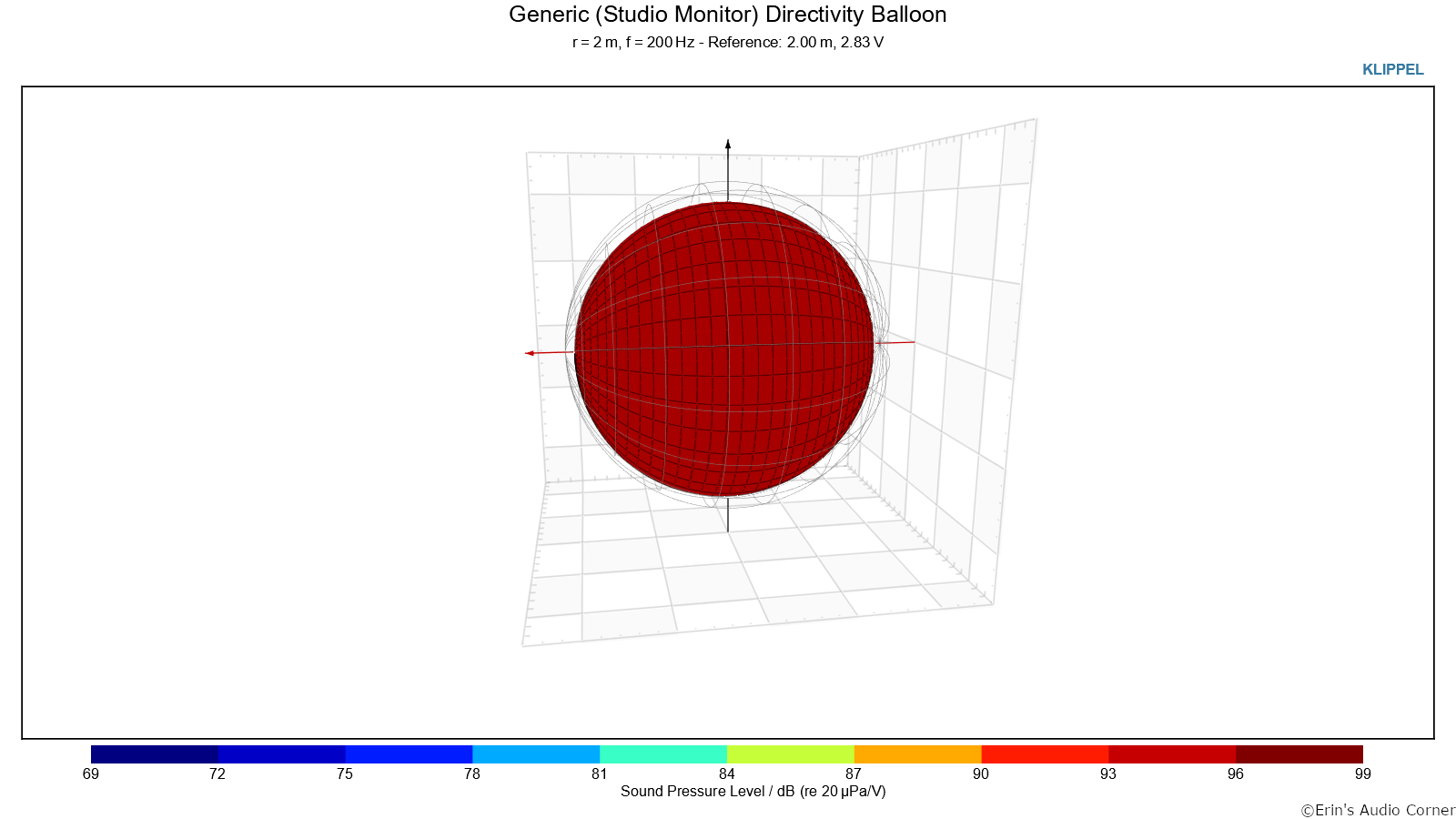
Now, let’s look at the response of the Dutch & Dutch 8c at 200Hz, below. What we see here is in stark contrast to the above. The first thing that stands out is there is practically zero sound radiating backwards (opposite of the red arrow). And what energy is back there is roughly 10-15dB down in level relative to what is firing forward.

What does this mean? This means the 8c is a very well designed cardioid speaker. The manufacturer claims as much. And this data backs it up.
Just for fun, I went another step and have provided a gif of the sound radiation at varying frequencies below. A few notes about this gif:

Parting / Random Thoughts
I encourage you to watch my YouTube review for more details but a quick few notes:
Contribute
If you like what you see here and want to help me keep it going, please consider donating via my PayPal Contribution page here. Donations help me pay for new items to test, hardware, miscellaneous items and costs of the site’s server space and bandwidth. All of which I otherwise pay out of pocket. So, if you can help chip in a few bucks, know that it’s very much appreciated.
You can also join my Facebook and YouTube pages if you’d like to follow along with updates.
Data can be downloaded here:
https://www.dropbox.com/s/ggqx5t2y05kbcup/Dutch & Dutch 8C.7z?dl=0
I tried to match the same format as Amir's for you guys who use the data to do stuff but I wouldn't be surprised if there are some differences. I'll try to resolve them. PM me.
https://www.erinsaudiocorner.com/loudspeakers/dutch_dutch_8c/
Note: The YouTube review isn't up yet. Hopefully will be this weekend. Didn't want to put off the release of the data any further.
Dutch & Dutch 8c Speaker Review
- Friday, Mar 5, 2021
Foreword / YouTube Video Review
The review on this website is a brief overview and summary of the objective performance of this speaker. It is not intended to be a deep dive. Moreso, this is information for those who prefer “just the facts” and prefer to have the data without the filler.
However, for those who want more - a detailed explanation of the objective performance, and my subjective evaluation (what I heard, what I liked, etc) - please watch the below video where I go more in-depth.
(Coming Soon)
Information and Photos
I have provided a introduction to this speaker on my YouTube channel and provided below.
The Dutch & Dutch 8c is a powered bookshelf speaker that is quite the departure from the typical bookshelf speaker. Its cardioid design means it is practically all forward-firing above approximately 100Hz. This enables the listener to place the speakers very close to a rear wall and get the benefit of boundary reinforcement without the negative characteristic of rear-wall reflections. It’s quite a neat theory that also has remarkable sonic achievements in practice.
The front of the speaker features a 1-inch dome tweeter and 8-inch midrange. The crossover between these two driver units is 1250Hz. The front baffle is one piece that fits over the drivers, resulting in a very smooth waveguide for the tweeter (notice the lack of screw heads and holes) as well as a smooth lip even on the midrange.
The rear features dual 8-inch subwoofers which play below 100Hz. The rear also contains the I/O ports (AES digital, as well as balanced analog via XLR) and even a pass through for a separate subwoofer.
The Dutch & Dutch 8c is an “all in one” product. It features a built-in amplifier with DSP allowing the user to tailor the speaker to their own tonal desires (bass, mid and treble adjustments). The 8c is also designed to integrate with Room EQ Wizard for room equalization. This feature works very well and is very easy to navigate and implement. The speaker connects to your network via wired ethernet cable. Once connected you can access the speaker’s DSP, volume control, source selection (analog/AES), etc. via your web browser. It is really quite easy and convenient.
I have taken the liberty of providing a screenshot of the technical specs from the manufacturer’s page, provided below:

CTA-2034 (SPINORAMA) and Accompanying Data
All data collected using Klippel’s Near-Field Scanner. The Near-Field-Scanner 3D (NFS) offers a fully automated acoustic measurement of direct sound radiated from the source under test. The radiated sound is determined in any desired distance and angle in the 3D space outside the scanning surface. Directivity, sound power, SPL response and many more key figures are obtained for any kind of loudspeaker and audio system in near field applications (e.g. studio monitors, mobile devices) as well as far field applications (e.g. professional audio systems). Utilizing a minimum of measurement points, a comprehensive data set is generated containing the loudspeaker’s high resolution, free field sound radiation in the near and far field. For a detailed explanation of how the NFS works and the science behind it, please watch the below discussion with designer Christian Bellmann:
A picture of the setup in my garage:
The reference plane in this test is halfway between the tweeter and the midrange, as shown in the image below:
Measurements are provided in a format in accordance with the Standard Method of Measurement for In-Home Loudspeakers (ANSI/CTA-2034-A R-2020). For more information, please see this link.
CTA-2034 / SPINORAMA:
Note: Since this is a powered speaker, the SPL readings in the below graphics was not the SPL tested. Per the CTA-2034 sped, the input voltagge is 2.83v. However, this speaker was tested at a level more in line with approximately 86dB at 1m (0.30vRMS input). The output SPL is scaled based on the 2.83v, though. Therefore, at 2.83v input to this speaker, the output is shown as below.

Early Reflections Breakout:

Estimated In-Room Response::

Horizontal Frequency Response (0° to ±90°):

Vertical Frequency Response (0° to ±30°):

Horizontal Contour Plot (not normalized):

Horizontal Contour Plot (normalized):

Vertical Contour Plot (not normalized):

Vertical Contour Plot (normalized):

Additional measurements
Nearfield response of individual drive units with anechoic on-axis response:

Harmonic Distortion at 86dB @ 1m:

Harmonic Distortion at 96dB @ 1m:

Horizontal Polar (Globe) Plot: This represents the sound field at 2 meters - above 200Hz - per the legend in the upper left.

Vertical Polar (Globe) Plot: This represents the sound field at 2 meters - above 200Hz - per the legend in the upper left.

“Above and Beyond” Measurements
Anechoic vs Boundary Loaded
These measurements are outside of my typical measurement set but I feel are necessary to provide additional insight in to the performance of this speaker. Thus, the “above and beyond” tag.
The Dutch & Dutch 8c is a speaker that breaks the norm. It is designed to be placed near a back wall in order to provide boundary gain. In order to achieve boundary gain, however, a typical speaker also loses timbre due to the rear wall reflections. With a cardioid speaker (such as the D&D 8c), the rear wall reflections are effectively “muted” and you are left with a forward-firing only speaker above 100Hz (below which, the subs are omnidirectional but cut off above this frequency sharply).
This presents a bit of a challenge when analyzing performance. Ideally you measure a speaker anechoically to see what happens when the room is not a factor in the performance. So, I did that using Klippel’s NFS which you saw above. This gave us all a baseline understanding of the speaker’s anechoic performance. However, I also needed a way to characterize performance in the situation it is designed for: near a boundary for below approximately 100Hz reinforcement. Therefore, I used high level engineering (see: scrap wood) to build a platform for the speaker so the subwoofers could load off the ground - effectively becoming the “rear wall”, if you will. And then I measured the performance in this manner. Now we have not only a full SPIN set of data for anechoic measurements but we also have a quasi-anechoic measurement via the ground plane method to see how the boundary loading changes performance.
Setup:
The 8c’s DSP settings were tested both “free” and set to “10cm” from the backwall. “Free” is essentially telling the speaker there is no rear wall behind it and there is no shelving of the bass. “10cm” is intended to emulate placement against a backwall in a real room and, when placed near a rear wall, will shelve the bass so the response is more neutral. As you can see in the below graphic, when the speaker is placed near a boundary and set to “free” the SPL increases from 0dB at 200Hz to approximately +6dB below about 80Hz. This gives us an idea of what to expect in a real room (to some degree). Ultimately, the takeaway here is that boundary gain works as expected and if you want a neutral response then the DSP should be set in accordance with the in-room backwall distance from the speaker.
Cardioid Performance
Conventional speakers are omnidirectional at low frequencies and become more directional at higher frequencies. Omnidirectional means that the sound is radiated 360° around the speaker. More directional means that the sound is “focused” more forward than it is behind or to the sides. For most bookshelf and floorstanding speakers, this is true below about 400-500Hz. Sometimes higher; sometimes lower. This is usually dictated by the size of the drive units used in the speaker.
A cardioid speaker - like the Dutch & Dutch 8c is designed to not be omnidirectional above a certain frequency, and in the case of the 8c that frequency is 100Hz. Why would this be useful? Well, remember, the 8c features subwoofers on the rear of the speaker. These subwoofers depend on boundary reinforcement in order for the response to extend as low as possible in frequency. The issue, typically, would be rear-wall reflections. If the 8c speaker had the upper midbass and lower midrange frequencies radiating backwards then there would be a high degree (no pun intended) of sound traveling rearward only to be reflected off the rear wall and back to the front of the speaker causing comb filtering in these lower frequencies. In terms of sound, this can (and typically does) result in marred tonality, impact and imaging of the mid-to-low frequencies at the listening position. The 8c claims to have “constant directivity” above 100Hz; something it does through its cardioid design.
How well does this actually work, though? Well, let’s take a look at the typical response of a generic studio monitor at 200Hz. The below graphic is a plot of the sound field of said speaker at 200Hz. This was generated using Klippel’s Near-Field Scanner and Visualization module. The story here is the sound is a big ball of energy, radiating in all directions. In front (illustrated by the red arrow), backwards, up and down. This energy is all practically the same SPL, too. Nothing new here. Typical of a standard monopole speaker.

Now, let’s look at the response of the Dutch & Dutch 8c at 200Hz, below. What we see here is in stark contrast to the above. The first thing that stands out is there is practically zero sound radiating backwards (opposite of the red arrow). And what energy is back there is roughly 10-15dB down in level relative to what is firing forward.

What does this mean? This means the 8c is a very well designed cardioid speaker. The manufacturer claims as much. And this data backs it up.
Just for fun, I went another step and have provided a gif of the sound radiation at varying frequencies below. A few notes about this gif:
- Look how the response is completely omnidirectional at 50Hz but practically all forward firing by 150Hz and by 200Hz is forward firing.
- You can see there is a mismatch in directivity in the crossover region (as illustrated by the balloon shape not being quite spherical at 2000Hz). This is also seen in the CTA-2034 data set.

Parting / Random Thoughts
I encourage you to watch my YouTube review for more details but a quick few notes:
- This speaker sounds phenomenal.
- Objectively speaking, the data indicates this is a terrific speaker. It is roughly ±1.5dB from 30Hz to 18kHz. That’s incredible.
- The data does indicate something - possibly a resonance - around 400Hz which appears to be caused by the 8-inch midrange (judging by the nearfield response). However, there was no hint of this when I specifically listened for this as an issue. Therefore, it could be another source or simply inaudible (Toole discusses this in his book )
- There is also a mild directivity mismatch at the crossover, but I am impressed it is so minimal given the size of the midrange and the center-to-center spacing of the tweeter/midrange. Of course, the 1250Hz crossover helps to alleviate this, though one expects an increase in distortion from the tweeter with such a relatively low crossover point. While the distortion profile is higher at 1kHz than at 2kHz , it appears this portion of the distortion profile is due to the midrange and not the tweeter. This indicates the tweeter is not being stressed at this low crossover point. There is no way to know for sure without testing the raw drive units with implemented crossover but I think that’s too far down in to the weeds (even for me).
- Speaking of distortion, I didn’t have any complaints even at much higher than typical listening levels (>100dB at 4 meters). At one point I was listening to these speakers at 105dB in my living room without a hint of mechanical trouble. I backed off the volume simply because those levels, full-range, are dangerous.
- The soundstage is something to behold. I truthfully expected, with the controlled directivity nature above 100Hz, that there would be less room interaction from the side walls and that would hurt the apparent source width (ASW), thus causing a more narrow soundstage. Um… Nope. Quite the opposite. Images were way outside the range where I expected and where I have heard with speakers with very wide radiation patterns. Crazy.
- The tonality of the speaker is great. The data indicates this should come as no surprise.
- The in-room response was +15dB at 30Hz. Yes, you read that correctly.
- Subjectively speaking, the maximum output SPL was approximately 105dB at the main listening position (4 meters away) for the pair of speakers playing full range (20Hz to 20kHz). Above this volume, I felt a bit apprehensive pushing the speaker further (I don’t own it and it isn’t cheap). 105dB full range at 4 meters is very loud.
- Integrating Room EQ Wizard DSP correction in to this speaker was not only a treat but incredibly easy.
- No audible “hiss” (problem with many powered speakers).
- I used these speakers both analog and digital. When using digital, I used this (relatively) $95 Hosa ODL-312 Optical SPDIF and AESEBU Digital Format Converter. This served to allow me to send my TV’s audio signal via optical output to the 8c speakers, thus enabling me to use all sources (TV, AppleTV, Blu-ray player).
- If you have the means and are considering this speaker, I recommend it.
Contribute
If you like what you see here and want to help me keep it going, please consider donating via my PayPal Contribution page here. Donations help me pay for new items to test, hardware, miscellaneous items and costs of the site’s server space and bandwidth. All of which I otherwise pay out of pocket. So, if you can help chip in a few bucks, know that it’s very much appreciated.
You can also join my Facebook and YouTube pages if you’d like to follow along with updates.
Data can be downloaded here:
https://www.dropbox.com/s/ggqx5t2y05kbcup/Dutch & Dutch 8C.7z?dl=0
I tried to match the same format as Amir's for you guys who use the data to do stuff but I wouldn't be surprised if there are some differences. I'll try to resolve them. PM me.
Last edited:

